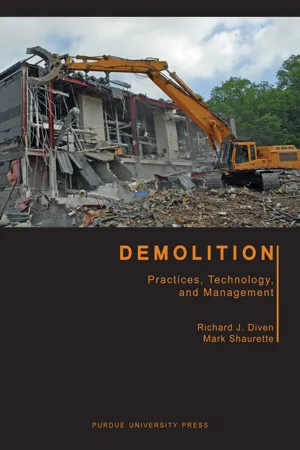
- 179 pages
- English
- ePUB (mobile friendly)
- Available on iOS & Android
About This Book
As the built environment ages, demolition has become a rapidly growing industry offering major employment opportunities. During the 1990s the number of contractors grew by nearly 60 percent and there are now over 800 US companies focused on demolition, as well as many more offering this service as part of their portfolio. It has also become an increasingly complex business, requiring a unique combination of project management skills, legal and contractual knowledge, and engineering skills from its practitioners. Created in partnership with the National Demolition Association, Demolition: Practices, Technology, and Management is written specifically with students of construction management and engineering in mind, although it will also be an invaluable reference resource for anyone involved in demolition projects. Since demolition has become such a central part of construction management, this audience includes practicing architects and engineers, general contractors, building and manufacturing facility owners, as well as government officials and regulators. Covered in the book is the full range of technical and management issues encountered by the demolition contractor and those who hire demolition contractors. These include modern demolition practices, the impact of different construction types, demolition regulations, estimating demolition work, demolition contracts, safety on the demolition project, typical demolition equipment, debris handling and recycling, use of explosives, demolition contractors' participation in disaster response, and demolition project management.
Frequently asked questions
Information
CHAPTER 1
INTRODUCTION TO THE INDUSTRY

A. IT’S NOT CONSTRUCTION
B. WHAT IS DEMOLITION?
Demolition Type | Description |
Commercial and Industrial Buildings and Structures—Low Rise Demolition | Any building/structure less than eight stories high; usually demolished using heavy equipment such as cranes and excavators equipped with special attachments. |
Commercial and Industrial Buildings and Structures—High Rise | Any building over eight stories in height; often demolished using explosives if surrounding conditions and local regulations permit. For non-explosive demolition, floors above eighty feet are usually demolished one floor at a time, and lower floors are demolished with heavy equipment. |
High Rise industrial structures such as chimneys, towers, chemical plants, steel mills, and similar structures | This category of demolition includes many special use buildings and structures. They are usually demolished using cranes, excavators, explosives, and various combinations of dismantling techniques. |
Sub-grade, Concrete Foundation Demolition | Often the most expensive part of a demolition project is the breaking and removal of heavy, below grade concrete foundations. Large excavators equipped with hydraulic breakers are commonly used to break the concrete. The crane and wrecking ball procedure is also used for breaking foundations. Explosives are used when conditions are suitable. |
Utility Demolition | This category can include any type of utilities either above or below grade and is usually a part of the primary demolition task. |
Demolition of Parking Lots, Roads, and Runways | These improvements can be either concrete or asphalt and are commonly performed as part of structure demolition, but may also be stand-alone projects. |
Bridge Demolition | Bridge demolition has become a major part of the demolition industry as our old bridges become obsolete. This category includes all types of bridges and materials used in their construction. |
Railroad Demolition | Includes primarily the removal of abandoned tracks, appurtenant structures, and railroad bridges. |
Interior Demolition | This is also a major category for demolition contractors and is typically the first step required for the processes of remodeling or upgrading existing buildings. |
Selective Demolition | This term can be applied to most any of the above categories in the sense that “selective demolition” may be defined as removal of specified parts of buildings, structures, utilities, and process equipment. For example, the end wall of a hospital building may need to be removed to permit the construction of an addition to the building. |
Explosive Demolition | Explosives used in demolition are typically used to fell buildings and structures or to break up heavy concrete foundations. The term “implosion” is used to describe the process of falling buildings in a controlled manner. A discussion of the use of explosives is included in chapter 11. |
Marine Demolition | This category covers demolition of pilings, docks, piers and foundations, sunken vessels, and underwater obstructions. |
Disaster Response | This is a broad category and includes cleanup of debris from hurricanes, earthquakes, fires, and floods. Included is the demolition of damaged structures and infrastructure. Also included are emergency rescues. |
Historical Salvage | This includes the careful removal and salvage of items of historical importance and is often performed by specialists in this kind of work. |
Hazardous Materials Removal | While not a direct demolition activity, the removal of hazardous materials such as asbestos-containing materials (ACM), polychlorinated biphenyls (PCBs), and other hazardous materials are performed as an integral phase of most demolition projects. Either the demolition contractor or a subcontractor will perform this work before demolition work begins. There are a number of regulations and laws governing such work. |
C. BRIEF HISTORY OF DEMOLITION
Table of contents
- Cover
- Title
- Copyright
- Table of Contents
- Foreword
- Preface
- Acknowledgments
- Chapter 1. Introduction to the Industry
- Chapter 2. The Demolition Contractor
- Chapter 3. Modern Demolition Practices
- Chapter 4. Types of Demolition—Building and Structures
- Chapter 5. Demolition Regulatory Guides
- Chapter 6. Estimating—Quantifying and Pricing the Demolition Project
- Chapter 7. Contracts and Accounting for the Demolition Project
- Chapter 8. Safety on a Demolition Project
- Chapter 9. Demolition Equipment
- Chapter 10. Material Handling and Recycling
- Chapter 11. Explosives in Demolition
- Chapter 12. Disaster Response
- Chapter 13. Project Management
- Glossary of Terms, Abbreviations, and Acronyms
- Index